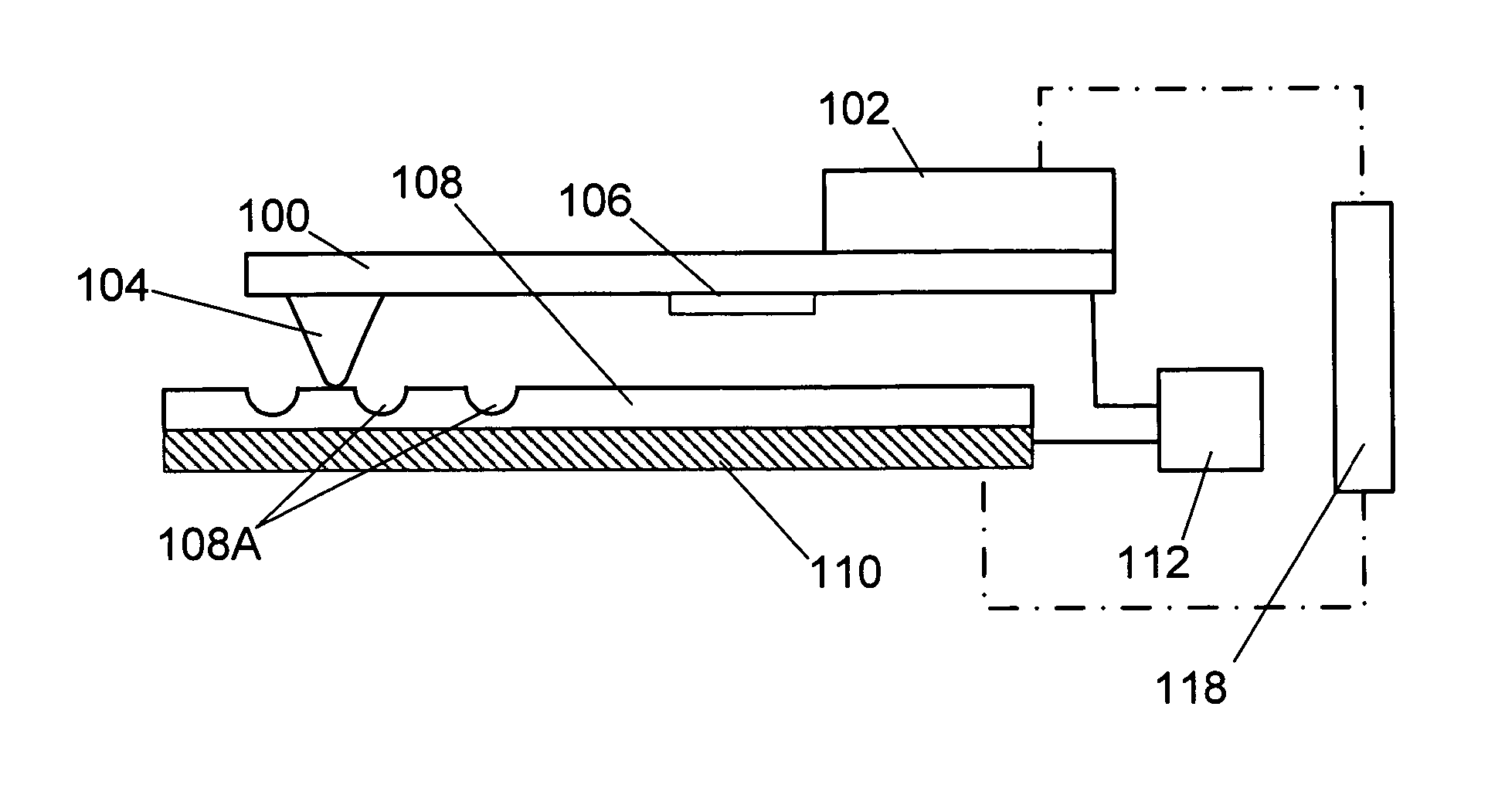Contact probe storage fet sensor and write heater arrangements
a technology of fet sensor and heater arrangement, which is applied in the field of read/write arrangement of contact probe storage (cps) arrangement, can solve the problems of system read performance thermal response being slower than desired, and significantly slower
- Summary
- Abstract
- Description
- Claims
- Application Information
AI Technical Summary
Problems solved by technology
Method used
Image
Examples
first embodiment
[0024]the invention is schematically illustrated in FIG. 3. It should be noted however, that the portion of the cantilever 100 which is depicted in FIGS. 3-6, is merely an end portion of the cantilever 100 that is able to move toward and away from the medium 108. As shown, the heater 116 is formed as an electrically conductive region having a suitable resistance, in a portion of the cantilever 100 which is located immediately proximate the probe 104.
[0025]The resistance of the heater 116 can be controlled by controlling the doping concentration with respect to that of the traces on either side which are more heavily doped and thus more conductive. As will be appreciated, the probe 104 itself can form part of the heater to facilitate localized heating and fusing of the medium 108.
[0026]The cantilever 100, in this embodiment, is formed of silicon which has been masked, etched and doped in a known manner to produce the illustrated configuration and electrically conductive lines or trac...
second embodiment
[0040]FIG. 4 shows the invention. In this embodiment the doped traces which form left and right hand side portions of the FET 214 are simplified. This configuration allows the end bridge 200C of the cantilever 200 to be narrowed and to add a minimum of thermal mass to the area of the cantilever 200 proximate the probe 204. It also limits the thermal conductivity out into the legs of the cantilever.
[0041]With the heater 216 interposed in the illustrated manner, the outboard traces both act as drains for the FET 214 while the inboard traces act as sources during the read mode and are switched in the same manner as disclosed in connection with the first embodiment shown in FIG. 3.
third embodiment
[0042]FIG. 5 shows the invention. In this embodiment the FET 314′ also acts as the heater during the heating mode and is such that the geometry of the FET elements maximizes the width of the FET in the vicinity of the probe 104. This embodiment accordingly has only one source 314B and one drain 314A.
[0043]The switching between the reading and writing mode is achieved one by operating the source and drain at voltages such that the FET was turned on partially. This places the channel in a state of medium conductivity where there would be a lot of voltage drop across it. Assuming that the substrate potential was fixed, the source voltage could be set to a value to establish the “on resistance” of the FET and the drain could be set to a voltage to cause the desired amount of power to be dissipated.
[0044]With this technique however, the power density in the channel may tend to be too high and the control of the FET may require accurately controlled voltages and the like.
PUM
| Property | Measurement | Unit |
|---|---|---|
| temperature | aaaaa | aaaaa |
| temperature | aaaaa | aaaaa |
| resistance | aaaaa | aaaaa |
Abstract
Description
Claims
Application Information
 Login to View More
Login to View More - R&D
- Intellectual Property
- Life Sciences
- Materials
- Tech Scout
- Unparalleled Data Quality
- Higher Quality Content
- 60% Fewer Hallucinations
Browse by: Latest US Patents, China's latest patents, Technical Efficacy Thesaurus, Application Domain, Technology Topic, Popular Technical Reports.
© 2025 PatSnap. All rights reserved.Legal|Privacy policy|Modern Slavery Act Transparency Statement|Sitemap|About US| Contact US: help@patsnap.com



